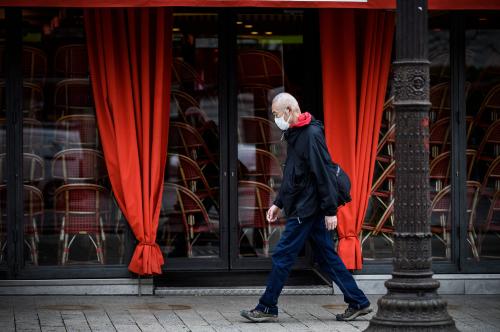On March 22, 2020, at the time of writing, the total number of recorded deaths from the novel coronavirus stood at just below 14,000. This is a large number and is bound to increase, exponentially for a time, but it needs to be understood in context. It can be large or small depending on the time frame, the geographic scale, and the demographic composition of the population affected.
Time frame
The number of COVID-19 fatalities is small compared to the 12 million total number of people who have already died this year from all causes, but the numbers could reach 3.6 million in just eight weeks at the current pace of deaths doubling each week. In the counterfactual, without COVID-19, we would expect 60 million global deaths in 2020, with 18 million people dying from heart disease, 10 million from cancer, 6.5 million from respiratory diseases, 1.6 million from diarrhea, 1.5 million in road incidents, and 1 million deaths from HIV/AIDS. Suicides could number 800,000.
It’s hard to estimate the impact on total deaths from the COVID-19 disease because, in addition to the direct effects that are measured, there are also large indirect effects from the policy responses. For a start, the direct impact itself is totally unknown and unknowable at this point. There are too many uncertainties to have any sensible range of estimates. At one end, it looks as if China may be able to contain deaths to about 3,500 (they are at 3,260 with about eight to 10 new deaths each day). This is less than 0.03 percent of the 10.5 million people who are expected to die in China this year.
Even if we look more narrowly at February/March, when COVID-19 mortality was highest in China, it was still only the 49th cause of death in the country (Figure 1).
It seems unlikely that the tally will be so low in other countries. Italy already has more than 15 times the total confirmed coronavirus cases per million population as China, with no signs of the rate of increase of new cases slowing down sharply. Deaths have already surpassed China’s toll and, given the known caseload, will continue to grow rapidly for at least two weeks even if current more restrictive quarantining practices start to work. COVID-19 was already the eighth leading cause of death in Italy in February/March (Figure 2).
Italy, of course, will likely not be the worst affected country. Italy is an advanced economy with a strong public health system and large numbers of hospital beds, ventilators, and other essentials to keep death rates low. The havoc that could be wreaked in developing countries without such advantages is unimaginable. Standard measures in the West, like social distancing, could be impossible to implement in Calcutta, Dhaka, or Lagos.
Complicating matters further is the difficulty of understanding the indirect impact of COVID-19, which can be both positive and negative. François Gemenne, of the Hugo Observatory, has even argued that “the death toll of the coronavirus at the end of the day might be positive, if you consider the deaths from atmospheric pollution.” This is not such a far-fetched idea. During the lockdown in China, particulate emissions fell. Using conservative estimates from four major Chinese cities, Marshall Burke, from of Stanford University, projects that “the lives saved due to the pollution reductions are roughly 20x the number of lives that have been directly lost to the virus.” On the other hand, the overburdening of the health system due to COVID-19 will surely create suffering for people who need normal emergency support and if there is no economic foundation, countries won’t be able to finance their health care systems anymore.
Location
Many numbers seem small when expressed in per capita terms in a populous country like China. The direct deaths from COVID-19 in China may be only 0.03 percent of China’s estimated 10.5 million deaths this year. It may be 10 times as large if we just focus on the month of February. If we narrow in on Hubei province, then COVID-19 deaths would still represent less than 1 percent of estimated deaths for 2020, but almost 7 percent of all deaths in Hubei in February (Figure 3). For the city of Wuhan (not shown), COVID-19 could represent over 2 percent of all the deaths in 2020 and increased deaths in February by a quarter.
Age
In China, Italy, and elsewhere, deaths from COVID-19 have been concentrated among seniors. In China, more than 50 percent of COVID-19 deaths have been people who are over 70 years old even though most COVID-19 cases are being contracted by people below 70. Young people have interpreted this as an indication that they do not need to worry about the virus, while old people are being warned to take extreme caution. It is true that young people have a smaller chance than old people of dying from COVID-19, but they have a smaller chance of dying of almost any other health risk as well. In China, the age at which people died from COVID-19 was very similar to the age at which people died normally (Figure 4). And there are already signs that the age profile of deaths in China may not be the same as the age profile elsewhere, so it is useful for people of all ages to take extreme care.
Space and time matter
China’s experience highlights, in dramatic fashion, how national aggregates can be misleading. Space and time matter. What is a blip for China at the national level with a perspective of one year has been a major disaster for Wuhan at a time scale of one month. Understanding the human dimension of the tragedy starts with an understanding of the specifics of people, time, and place, the same principles that lie behind the “leave no one behind“ slogan of the U.N.’s Agenda 2030.
The data from China also show the impact of effective public action. China has contained the virus for now. But only a few weeks ago, Wuhan was the world’s COVID-19 battlefield. If the infection had been left unchecked, China would have experienced a dramatic outcome. Small numbers create big impacts if they grow exponentially. China’s 3,500 deaths would have translated into 3.6 million deaths after only 10 doublings (10 weeks in current COVID transmission terms). If you are currently living in quarantine and are unsure about the measures your government has imposed on you, trust the fundamentals of mathematics. If you see an exponential trend, you need to start social distancing very early. Otherwise the eventual impact will be beyond comprehension.
Note: For question regarding the underlying data and resulting estimates, please contact Katharina Fenz ([email protected]). We thank Wolfgang Fengler for his inputs and review.













Commentary
A mortality perspective on COVID-19: Time, location, and age
March 23, 2020